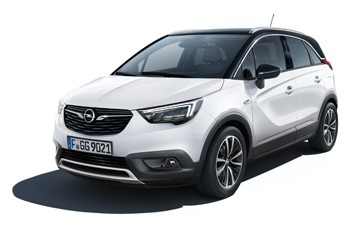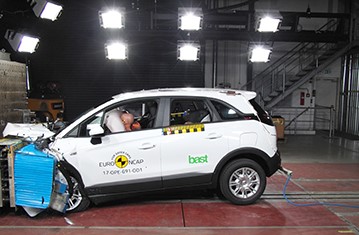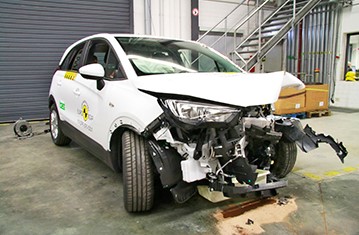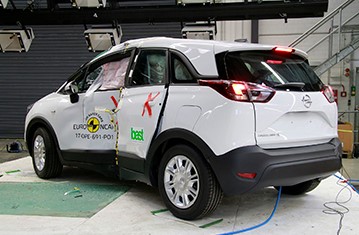- With standard equipment
- With safety pack
Find more information in the General Comments section of the assessment
Find more information in the Rating Validity tab of the assessment
- See More
- See More
- See More
- See More
- Good
- Adequate
- Marginal
- Weak
- Poor
 Passenger
Passenger
 Driver
Driver
 Rear Passenger
Rear Passenger
 Driver
Driver
 Car
Car
 Pole
Pole
 Rear Seat
Rear Seat
 Front Seat
Front Seat
- Good
- Adequate
- Marginal
- Weak
- Poor


Passenger
outboard
center
Fitted to the vehicle as standard
Not fitted to the test vehicle but available as option
Not Available
-
i-Size CRS
-
ISOFIX CRS
-
Universal Belted CRS
Easy
Difficult
Safety critical
Not allowed
| Seat Position | ||||
|---|---|---|---|---|
| Front | 2nd row | |||
| Passenger | Left | center | Right | |
| Maxi Cosi 2way Pearl & 2wayFix (rearward) (iSize) | ||||
| Maxi Cosi 2way Pearl & 2wayFix (forward) (iSize) | ||||
| BeSafe iZi Kid X2 i-Size (iSize) | ||||
| Maxi Cosi Cabriofix & FamilyFix (ISOFIX) | ||||
| BeSafe iZi Kid X4 ISOfix (ISOFIX) | ||||
| Britax Römer Duo Plus (ISOFIX) | ||||
| Britax Römer KidFix XP (ISOFIX) | ||||
| Maxi Cosi Cabriofix (Belt) | ||||
| Maxi Cosi Cabriofix & EasyBase2 (Belt) | ||||
| Britax Römer King II LS (Belt) | ||||
| Britax Römer KidFix XP (Belt) | ||||
Easy
Difficult
Safety critical
Not allowed
In the frontal offset test protection of both the 6 year and the 10 year dummies was good or adequate for all critical parts of the body. In the side barrier test protection was good and maximum points were scored. The front passenger airbag can be disabled to allow a rearward-facing child restraint to be used in that seating position. Clear information is provided to the driver regarding the status of the airbag and the system was rewarded. The Crossland X is not approved for Universal belted child restraints in the rear centre position but, otherwise, restraints could be properly installed and accommodated.
- Good
- Adequate
- Marginal
- Weak
- Poor

Head Impact 16.0 Pts
Pelvis Impact 4.2 Pts
Leg Impact 6.0 Pts
The bonnet provided protection that was largely good or adequate to the head of a struck pedestrian, with poor results being recorded along the base of the windscreen and on the stiff windscreen pillars. The bumper scored maximum points in tests of its protection of pedestrians' legs. Protection of the pelvis was also mostly good. The optional autonomous emergency braking system is capable of detecting pedestrians but is not included in this assessment.
- Good
- Adequate
- Marginal
- Weak
- Poor
| System Name | Cruise control with speed limiter and intelligent speed adaption |
| Speed Limit Information Function | Camera based |
| Warning Function | System advised |
| Speed Limitation Function | System advised (accurate to 5km/h) |
| Applies To | All seats | ||
| Warning | Driver Seat | Front Passenger(s) | Rear Passenger(s) |
| Visual | |||
| Audible | |||
|
|||
| System Name | Lane Departure Warning |
| Type | Lane Departure Warning |
| Operational From | 60 km/h |
| Warning | Audible |
| Performance | |
|
LDW Confirmation Test
|
Pass |
A seatbelt reminder is fitted as standard for the front and rear seats. The speed assistance system recognises local speed limits and allows the driver to easily set the limiter appropriately. A lane departure warning system is also standard. An autonomous emergency braking system is available as an option but, as it is an option, it is not included in this assessment.
- Specifications
- Safety Equipment
- Videos
- Rating Validity
Specifications
Tested Model Opel/Vauxhall Crossland X 1.2 'Edition', LHD
Body Type - 5 door SUV
Year Of Publication 2017
Kerb Weight 1163kg
VIN From Which Rating Applies - all Crossland X
Class Small MPV
Safety Equipment
Note: Other equipment may be available on the vehicle but was not considered in the test year.
Fitted to the vehicle as standard
Fitted to the vehicle as part of the safety pack
Not fitted to the test vehicle but available as option or as part of the safety pack
Not available
Not applicable
Videos
Rating Validity




Find more information in the General Comments section of the assessment
 Share
Share









The passenger compartment of the Crossland X remained stable in the frontal offset test. Dummy readings indicated good protection of the knees and femurs of both driver and passenger. Opel showed that a similar level of protection would be provided to occupants of different sizes and to those sat in different positions. In the full-width rigid-barrier test, protection of the chest of the rear passenger was rated as marginal, based on dummy readings of compression but, otherwise, protection of both dummies was good or adequate. In both the side barrier test and the more severe side pole impact, protection of all critical body areas was good and the car scored maximum points. Tests on the front seats and head restraints demonstrated good protection against whiplash injury in the event of a rear-end collision. However, the rear head restraints could not be adjusted high enough and whiplash protection here was rated as poor. An autonomous emergency braking system is available as an option but, as it is an option, it is not included in this assessment.